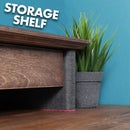Introduction: The Valentines Rose
Roses are synonymous with Valentines Day. Roses don't last long unfortunately... unless they're made from steel and have a hardwood epoxy base! The base features a blue resin lake and walnut hills.
This project is a collaboration between myself and JR Wood & Metal. He has a video showing how he made the steel rose I use in this project.
Supplies
Materials Used:
- Beach & Walnut Wood
- Glass Cloche
- Resin (Mixing pot, mixing stick & scales)
- Pearlex Powder
- Spray Lacquer
- Wood Glue
- Super Glue
- Painters Tape
- Paper
Tools Used:
- Router, Trammel & Bits
- Bandsaw
- Belt Sander
- Drill
- Scissors
- Sandpaper
Step 1: Carve the Base
I glued up 2 pieces of beach wood to get roughly a 250mm square. This will be cut into a circle shape later but first I wanted to trace around the glass cloche to give me a rough guide to carve to. I thought a resin 'lake' would be a really nice addition to this project so I drew a rough line to represent the lake on the right hand side.
Using a straight bit in the router I carved away the area for the lake. I also carved away a slightly deeper area in the middle. This will hopefully give the appearance of a deeper section of the lake too.
Step 2: Pour the Resin
The resin I used is a water simulating resin that is also self degassing. So all being will I wont have any air bubbles to worry about. It gets mixed to a ratio of 2:1. I went with 60 grams of resin and 30 grams of hardener. This gave me 90 grams total.
To give the lake its blue colour I used some blue perlex powder. I added a small amount, mixed it and then added a little more. I did also add some turquoise perlex powder but it didnt give the contrast I had hoped for. Pouring the resin is always the best part. Seeing how it flows and fills the area you carved away.
The resin I used takes 3 days to fully dry and cure. When it is fully cured its rock solid.
Step 3: Cut Out the Base
To cut out the base to a perfect circle I used a trammel on my router. This was just a scrap piece of plywood I mounted to my router base and drilled a hole for it to pivot around. This will pivot around a 6mm drill bit in the centre of the base.
I first carved an inner circle that will allow the glass cloche to sit in place. I carved about 5mm deep for this circle. To cut the outer circle I moved the pivot pint so it would cut a large circle. I made multiple passes so it would cut all the way through the base.
Step 4: Carve the Hills
The next stage was to carve the walnut hills. I did start cutting them before realising I could make a paper template to make things a lot easier. I traced around the edge of the resin and the edge or the circle carving. Cutting it out gave me a representation of the area I needed to fill with hills. The paper is much easier to trace around now though.
Trace the shape onto pieces of walnut, cutting them on the bandsaw and then shaping them on the belt sander to get them to fit the space was the next step.
Shaping on the bandsaw is nice and easy to do. Take it slow and keep offering the pieces up to see how the fit is coming along. Once the outer shape looks right and the 2 piece are coming together well then its time to shape the overall hill profile.
This was done with the bandsaw and belt sander too. The more random the shape the better. Only thing I made sure to do was to have a dip in the middle of the front hill. This is where the rose will be placed. I also made sure the edge meeting the resin was thinned out to look like a bank or beach.
Step 5: Glue the Hills to the Base
I used gloss spray lacquer for the finish. The painters tape on the base will leave a clean section to the wood so it will adhere better with the glue late.
To glue the walnut hills in place I used both wood glue and super glue. Wood glue for its strength and super glue for its fast holding power. The super glue will hold them in place while the wood glue dries.
One of the last thing to do is to drill a 6mm hole to receive the stem of the steel rose.
Super glue will secure the rose in place.
Step 6: Done
Here is the finished piece. I really hope you like it! Don't forget to check out Josh's video to see how he made the incredible steel rose!

Participated in the
Heart Contest













